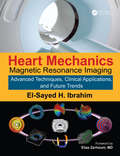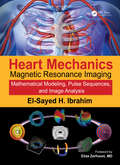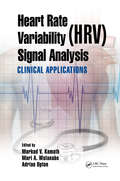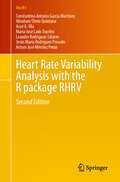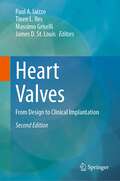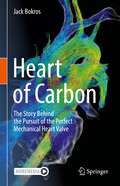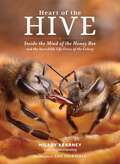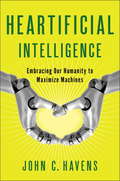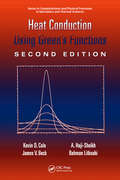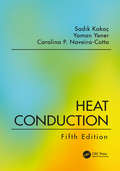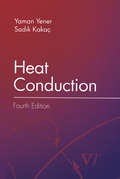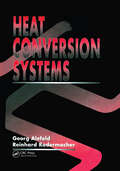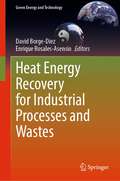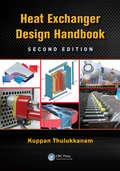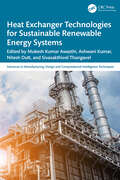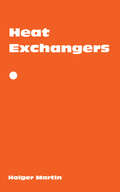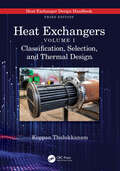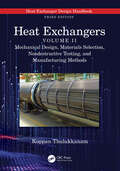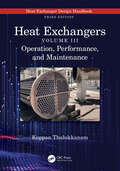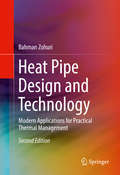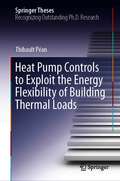- Table View
- List View
Heart Mechanics: Magnetic Resonance Imaging—Advanced Techniques, Clinical Applications, and Future Trends
by El-Sayed H. IbrahimBased on research and clinical trials, this book details the latest research in magnetic resonance imaging (MRI) tagging technology related to heart mechanics. It covers clinical applications and examines future trends, providing a guide for future uses of MRI technology for studying heart mechanics.
Heart Mechanics: Magnetic Resonance Imaging—Mathematical Modeling, Pulse Sequences, and Image Analysis
by El-Sayed H. IbrahimMRI techniques have been recently introduced for non-invasive qualification of regional myocardial mechanics, which is not achievable with other imaging modalities. Covering more than twenty-three years of developments in MRI techniques for accessing heart mechanics, this book provides a plethora of techniques and concepts that assist readers choose the best technique for their purpose. It reviews research studies and clinical trials that implemented MRI techniques for studying heart mechanics.
Heart Rate Variability (HRV) Signal Analysis: Clinical Applications
by Markad V. Kamath Mari A. Watanabe Adrian R.M. UptonOpen a Window into the Autonomic Nervous SystemQuantifying the amount of autonomic nervous system activity in an individual patient can be extremely important, because it provides a gauge of disease severity in a large number of diseases. Heart rate variability (HRV) calculated from both short-term and longer-term electrocardiograms is an ideal win
Heart Rate Variability Analysis with the R package RHRV (Use R!)
by Xosé A. Vila Leandro Rodríguez-Liñares Constantino Antonio García Martínez Abraham Otero Quintana María José Lado Touriño Jesús María Rodríguez Presedo Arturo José Méndez PenínThis book introduces readers to the fundamental concepts of Heart Rate Variability (HRV) and its most important analysis algorithms using a hands-on approach based on the open-source RHRV software. HRV refers to the variation over time of the intervals between consecutive heartbeats. Despite its apparent simplicity, HRV is one of the most important markers of autonomic nervous system activity and it has been recognized as a useful predictor of several pathologies. The book discusses all the basic HRV topics, including the physiological contributions to HRV, clinical applications, HRV data acquisition, HRV data manipulation and HRV analysis using time-domain, frequency-domain, time-frequency, nonlinear and fractal techniques. Detailed examples based on real data sets are provided throughout the book to illustrate the algorithms and discuss the physiological implications of the results. Offering a comprehensive guide to analyzing beat information with RHRV, the book is intended for masters and Ph.D. students in various disciplines such as biomedical engineering, human and veterinary medicine, biology, and pharmacy, as well as researchers conducting heart rate variability analyses on both human and animal data. The second edition of the book has been updated to RHRV version 5.0. This version introduces a functionality to perform heart rate variability analysis on entire populations. This functionality automates and streamlines both the calculation of HRV indices in the time, frequency, and nonlinear domains, as well as the subsequent statistical analysis.
Heart Valves: From Design to Clinical Implantation
by Paul A. Iaizzo James D. St. Louis Tinen L. Iles Massimo GriselliThis state-of-the-art handbook is dedicated to cardiac valve anatomy, models for testing and research methods, clinical trials; and clinical needs and applications. In this new edition, chapters are updated with the latest research in addition to new chapters on complex repair of CHD requiring conduits, new trends for valve replacement like the Ozaki procedure, as well as complex procedures in TAV, SAV, HARPOON, and BASILICA, with case studies for each type of procedure. This volume serves as a helpful reference for patients, educators, students, device designers and developers, clinical study specialists, clinicians, and other associated healthcare providers.
Heart of Carbon: The Story Behind the Pursuit of the Perfect Mechanical Heart Valve
by Jack BokrosThis book offers a historical account of the development of the On-X carbon mechanical heart valve, discussing the steps involved in developing the materials, and describes how the design of the valve has evolved over the years. It explores both the scientific and corporate problems researchers have encountered over the years in the journey of making a mechanical heart valve. The chapters provide a detailed description of the design of the mechanical leaflet-based prosthetic valve, with a particular focus on blood flow characteristics. This book includes an overview of the state-of-the-art in the chemistry and physics of carbon, and compiles the advances in carbon-based technology and its applications in cardiac and thoracic surgery.This is an ideal book for bioengineers working on the chemistry and physics of carbon, and other professionals involved with cardiac and thoracic surgery.
Heart of the Hive: Inside the Mind of the Honey Bee and the Incredible Life Force of the Colony
by Hilary KearneyExpert beekeeper and swarm-catcher Hilary Kearney offers a unique window into the social lives and biology of these remarkable creatures, accompanied by the photos of world-renowned bee photographer Eric Tourneret. Readers will be awestruck by the hive as superorganism and how the individual bee lives and behaves within it, perfectly suited to each specific job it performs. From their intricate dances and information-rich pheromones to how they sense and respond to their environment, learn, and remember, this immersive journey into the world of bees offers an entirely new perspective on the wisdom of nature and our relationship to it.
Heart on Pluto
by Karl JonesLove is everywhere, even in the fartherst reaches of the Solar System. On NASA's first-ever mission to Pluto, the New Horizons satellite discovers that even when you're far from home, you are loved.New Horizons was the first NASA satellite to visit and take close-up images of Pluto. And though the journey was long and challenging, New Horizons discovered a message of love in the heart-shaped nitrogren ice lake on Pluto's surface.
Heartificial Intelligence
by John HavensAs we program machines to be more like humans, how will they know what we value, if we don't know ourselves?The notion of robots gaining consciousness is beginning to become a reality, but the future of human happiness is dependent on our ability to teach machines what we value the most today. Featuring pragmatic solutions drawing on economics, emerging technologies, and positive psychology, Heartificial Intelligence provides a road map to help readers embrace the present and better define their future. Using fictional vignettes to help readers relate to larger concepts, this book paints a vivid portrait of how our lives might look in either a dystopia of robot dominance or a utopia where we use technology to enhance our natural abilities and evolve into a long-lived, super-intelligent, and caring species.ta that can be mined to reveal not just our buying habits and patterns, but how these patterns are impacted by our mood, the time of year, our location, and our interests?As Havens points out in H(app)inomics, the future needn't look so grim. Indeed, if we can wrest control of our personal data from corporations and use it to better understand ourselves, Havens argues, then we can combat this looming future and make love of life our most important personal economy.
Heat Conduction Using Greens Functions (Series in Computational Methods and Physical Processes in Mechanics and Thermal Sciences)
by James Beck A. Haji-Sheikh Bahman Litkouhi Kevin ColeSince its publication more than 15 years ago, Heat Conduction Using Green's Functions has become the consummate heat conduction treatise from the perspective of Green's functions-and the newly revised Second Edition is poised to take its place. Based on the authors' own research and classroom experience with the material, this book organizes the so
Heat Conduction, Fifth Edition
by Yaman Yener Carolina P. Naveira-Cotta Sadık KakacHeat Conduction, Fifth Edition, upholds its reputation as the leading text in the field for graduate students, and as a resource for practicing engineers. The text begins with fundamental concepts, introducing the governing equation of heat conduction, and progresses through solutions for one-dimensional conduction, orthogonal functions, Fourier series and transforms, and multi-dimensional problems. Integral equations, Laplace transforms, finite difference numerical methods, and variational formulations are then covered. A systematic derivation of the analytical solution of heat conduction problems in heterogeneous media, introducing a more general approach based on the integral transform method, has been added in this new edition, along with new and revised problems, and complete problem solutions for instructors.
Heat Conduction, Fourth Edition
by Yaman Yener Sadik KakacNearly thirty years since its first publication, the highly anticipated fourth edition of Heat Conduction upholds its reputation as an instrumental textbook and reference for graduate students and practicing engineers in mechanical engineering and thermal sciences. Written to suit a one-semester graduate course, the text begins with fundamental concepts, introducing the governing equation of heat conduction as derived from the First law of Thermodynamics. Solutions for one-dimensional conduction follow, then orthogonal functions, Fourier series and transforms, and multi-dimensional problems. Later sections focus on a series of specialized techniques, including integral equations, Laplace transforms, finite difference numerical methods, and variational formulations. Two new chapters (9 and 11) have been added to cover heat conduction with local heat sources and heat conduction involving phase change. Applications of Fourier transforms in the semi-infinite and infinite regions have been added to Chapter 7 and Chapter 10 has been expanded to include solutions by the similarity method. Also new to the fourth edition are additional problems at the end of each chapter.
Heat Conversion Systems
by Reinhard Radermacher Georg AlefeldHeat Conversion Systems develops the underlying concepts of advanced Rankine-based absorption and compression cycles and introduces the Building Block Approach as a general concept. The Building Block Approach identifies all cycle configurations for a given application to ensure that system designers have available all important alternatives. The book features numerous examples of advanced cycles and includes single- and multi-stage absorption heat pumps and heat transformers and combined systems. The book also discusses single- and multi-stage vapor compression systems with multiple solution circuits, multiple compressors, and cascades. Aspects of working fluid selection and their influence on cycle options, performance evaluation, and estimating procedures for the Coefficient of Performance (COP) are addressed. Cycle analysis based on the Second Laws of Thermodynamics is examined. Heat Conversion Systems will be an important source for engineers in air-conditioning, heat pumping, refrigeration, and waste heat utilization. It can be used as text in courses on thermodynamics, efficient use of energy, and environmental protection.
Heat Energy Recovery for Industrial Processes and Wastes (Green Energy and Technology)
by Enrique Rosales-Asensio David Borge-DiezThis book provides new techniques for recovering exhaust heat from gas turbines, natural gas combined cycle power plants, biomass boilers, and waste heat recovery from compost and wastewater treatment plants The book provides modeling for the study and comparison of combined cycle power plants with a heat recovery boiler of three pressure levels with reheating, inserting a technological improvement of solar hybridization and partial regeneration in the gas turbine. It assesses the environmental impacts and economic sustainability associated with these improvements. In addition, it proposes emissions minimization, with exhaust gas recirculation (EGR), and emissions treatment with a CO2 capture plant (CCP) and combined cycle power plant. Finally, it provides new insights into heat recovery from compost and exhaust gases recovery from wastewater treatment plants.
Heat Exchanger Design Handbook (Mechanical Engineering)
by Kuppan ThulukkanamCompletely revised and updated to reflect current advances in heat exchanger technology, Heat Exchanger Design Handbook, Second Edition includes enhanced figures and thermal effectiveness charts, tables, new chapter, and additional topics--all while keeping the qualities that made the first edition a centerpiece of information for practicing engine
Heat Exchanger Technologies for Sustainable Renewable Energy Systems (Advances in Manufacturing, Design and Computational Intelligence Techniques)
by Ashwani Kumar Mukesh Kumar Awasthi Nitesh Dutt Sivasakthivel ThangavelHeat Exchanger Technologies for Sustainable Renewable Energy Systems serves as a comprehensive resource on the cutting-edge advancements and applications of heat exchanger technologies in the realm of renewable energy. This book delves into the fundamental principles, design methodologies, and operational strategies for optimizing heat exchange processes in various sustainable energy systems.Covering a wide range of topics, the book explores innovative heat exchanger designs, materials, and configurations that enhance thermal performance and efficiency. It examines the integration of heat exchangers in solar thermal systems, geothermal applications, and biomass energy systems, providing insights into their role in promoting energy conservation and sustainability.The content encompasses both theoretical frameworks and practical applications, featuring case studies that illustrate successful implementations of heat exchanger technologies in real-world scenarios. Readers will gain a thorough understanding of performance evaluation metrics, modeling techniques, and experimental methodologies used to assess heat exchanger efficiency.Key features of the book: Discusses the principles of heat transfer and fluid dynamics relevant to heat exchangers. Investigates emerging materials and design innovations for enhanced thermal performance. Explores the application of heat exchangers in various renewable energy systems, including solar, geothermal, and biomass. Provides in-depth analysis of modeling techniques and performance evaluation criteria. Highlights recent developments in heat exchanger technologies and their impact on sustainability. Targeted at researchers, engineers, and students in the fields of renewable energy, mechanical engineering, and environmental science, this book is an essential guide for anyone seeking to advance their understanding of heat exchanger technologies and their vital role in sustainable energy systems.
Heat Exchangers
by Holger MartinThis is a text/reference illustrating thermal and hydraulic design of heat exchangers. The book shows how to apply the fundamentals of thermodynamics, heat transfer, and fluid dynamics for a systematic analysis of the phenomena in heat exchangers, important to energy effective operation in process plants. Beginning with illustrative examples detailing applications of fundamentals, the text then shows the influence of flow configuration on the performance of heat exchangers. Here the equations to calculate mean temperature difference and efficiency for stirred tank, parallel, counter-and cross flow and their combinations are derived and put together in a new and very compact way. In some cases, short computer programs are given to evaluate more complicated formulas or algorithms. Chapter 3 is comprised of seven fully worked out examples showing application of the fundamentals to thermal and hydraulic design, i.e. sizing of heat exchangers. It includes problems and worked examples and is written in a self study format. The text should be useful to practicing engineers and also graduate students in chemical and mechanical engineering.
Heat Exchangers: Classification, Selection, and Thermal Design
by Kuppan ThulukkanamHeat Exchangers: Classification, Selection, and Thermal Design, Third Edition discusses heat exchangers and their various applications, such as refrigeration, air conditioning, automobiles, gas turbines, process industries, refineries, and thermal power plants.With a focus on thermal design methods, including rating and sizing, the book covers thermohydraulic fundamentals and thermal effectiveness charts for various flow configurations and shell and tube heat exchangers. It provides construction details, geometrical features and correlations, and thermo-hydraulic details for tube-fin, plate fin, air-cooled, shell and tube, microchannel, and plate heat exchangers and thermal design methods like rating and sizing. The book explores additive manufacturing of heat exchangers, printed circuit heat exchangers, and heat transfer augmentation methods. The book also describes recuperators and regenerators of gas turbine cycles, waste heat recovery devices, and phase change phenomena including boiling, condensation and steam generation.The book serves as a useful reference for researchers, graduate students, and engineers in the field of heat exchanger design, including heat exchanger manufacturers.
Heat Exchangers: Mechanical Design, Materials Selection, Nondestructive Testing, and Manufacturing Methods
by Kuppan ThulukkanamHeat Exchangers: Mechanical Design, Materials Selection, Nondestructive Testing, and Manufacturing Methods, Third Edition covers mechanical design of pressure vessels and shell and tube heat exchangers, including bolted flange joint design, as well as selection of a wide spectrum of materials for heat exchanger construction, their physical properties, corrosion behavior, and fabrication methods like welding.Discussing the basics of quality control, the book includes ISO Standards for QMS, and references modern quality concepts such as Kaizen, TPM, and TQM. It presents Six Sigma and Lean tools, for heat exchangers manufacturing industries. The book explores heat exchanger manufacturing methods such as fabrication of shell and tube heat exchangers and brazing and soldering of compact heat exchangers.The book serves as a useful reference for researchers, graduate students, and engineers in the field of heat exchanger design, including pressure vessel manufacturers.
Heat Exchangers: Operation, Performance, and Maintenance
by Kuppan ThulukkanamHeat Exchangers: Operation, Performance, and Maintenance, Third Edition covers heat exchanger installation, commissioning and operation, and maintenance and performance monitoring in service.Focusing on in-service issues like flow-induced vibration, corrosion, and corrosion control, and fouling and fouling control, the book explores performance deterioration in service, maintenance issues, defects, tube failures, and how to detect these issues with NDT methods. It discusses various cleaning processes and repair methods. The book also considers boilers, utility boilers, coal-based thermal power plants, boiler corrosion, and boiler degradation mechanisms. It discusses different types of cooling systems, feedwater treatment, deaerators, feedwater heaters, economizers, condensers, cooling towers, and cooling-water management.The book serves as a useful reference for researchers, graduate students, power plant engineers, and engineers in the field of heat exchanger design, including pressure vessel manufacturers.
Heat Pipe Design and Technology
by Bahman ZohuriThis book provides a practical studyof modern heat pipe engineering, discussing how it can be optimized for use on a wider scale. An introduction to operationaland design principles, this book offers a review of heat and mass transfer theory relevant to performance, leading into and exploration of the use of heat pipes, particularlyin high-heat flux applications and in situations in which there is anycombination of non-uniform heat loading, limited airflow over the heat generatingcomponents, and space or weight constraints. Key implementation challenges are tackled, including load-balancing, materials characteristics, operating temperature ranges, thermal resistance, and operating orientation. With its presentation of mathematicalmodels to calculate heat transfer limitations and temperature gradient of bothhigh- and low-temperature heat pipes, the book compares calculated results withthe available experimental data. It also includes a series of computer programs developed by theauthor to support presented data, aid design, and predict performance.
Heat Pipes and Solid Sorption Transformations: Fundamentals and Practical Applications
by Sadik Kakaç L. L. VasilievDeveloping clean energy and utilizing waste energy has become increasingly vital. Research targeting the advancement of thermally powered adsorption cooling technologies has progressed in the past few decades, and the awareness of fuel cells and thermally activated (heat pipe heat exchangers) adsorption systems using natural refrigerants and/or alt
Heat Pump Controls to Exploit the Energy Flexibility of Building Thermal Loads (Springer Theses)
by Thibault PéanThis book describes different control strategies adapted to heat pumps, at the purpose of increasing energy flexibility in buildings. It reports on the development of both simple rule-based controls (RBC) and advanced model predictive controls (MPC). These are tested and compared in both simulation and experimental setups. The book analyzes in detail all the different steps, including the development and tuning of the controllers, their testing in experimental settings and simulation studies. Bridging between advanced control systems theory concepts and practical needs, and discussing the advantages and main challenges of MPC and RBC controllers in terms of efficiency of heat pump operation, electricity prices, emission values, and users’ comfort, this book offers an in-depth evaluation of innovative control strategies applied to energy demand management in buildings.
Heat Pump Dryers: Theory, Design and Industrial Applications
by Odilio Alves-FilhoExplore the Social, Technological, and Economic Impact of Heat Pump DryingHeat pump drying is a green technology that aligns with current energy, quality, and environmental concerns, and when compared to conventional drying, delivers similar quality at a lower cost. Heat Pump Dryers: Theory, Design and Industrial Applications details the progressio
Heat Pump Planning Handbook
by Jürgen BoninThe Heat Pump Planning Handbook contains practical information and guidance on the design, planning and selection of heat pump systems, allowing engineers, designers, architects and construction specialists to compare a number of different systems and options. Including detailed descriptions of components and their functions and reflecting the current state of technology this guide contains sample tasks and solutions as well as new model calculations and planning evaluations. Also economic factors and alternative energy sources are covered, which are essential at a time of rising heat costs. Topics included: Ecological and economic aspects Introduction to Refrigeration Water heat pump systems Configuration of all necessary components Planning Examples (Problems and Solutions)
